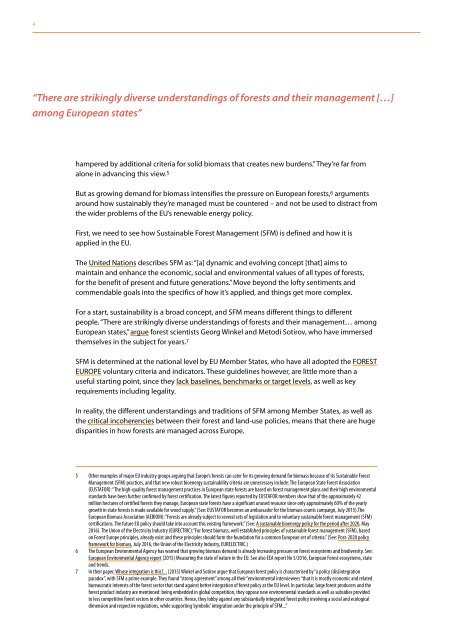A dangerous delusion
zgv5wg5
zgv5wg5
Create successful ePaper yourself
Turn your PDF publications into a flip-book with our unique Google optimized e-Paper software.
4<br />
“There are strikingly diverse understandings of forests and their management […]<br />
among European states”<br />
hampered by additional criteria for solid biomass that creates new burdens.” They’re far from<br />
alone in advancing this view. 5<br />
But as growing demand for biomass intensifies the pressure on European forests, 6 arguments<br />
around how sustainably they’re managed must be countered – and not be used to distract from<br />
the wider problems of the EU’s renewable energy policy.<br />
First, we need to see how Sustainable Forest Management (SFM) is defined and how it is<br />
applied in the EU.<br />
The United Nations describes SFM as: “[a] dynamic and evolving concept [that] aims to<br />
maintain and enhance the economic, social and environmental values of all types of forests,<br />
for the benefit of present and future generations.” Move beyond the lofty sentiments and<br />
commendable goals into the specifics of how it’s applied, and things get more complex.<br />
For a start, sustainability is a broad concept, and SFM means different things to different<br />
people. “There are strikingly diverse understandings of forests and their management… among<br />
European states,” argue forest scientists Georg Winkel and Metodi Sotirov, who have immersed<br />
themselves in the subject for years. 7<br />
SFM is determined at the national level by EU Member States, who have all adopted the FOREST<br />
EUROPE voluntary criteria and indicators. These guidelines however, are little more than a<br />
useful starting point, since they lack baselines, benchmarks or target levels, as well as key<br />
requirements including legality.<br />
In reality, the different understandings and traditions of SFM among Member States, as well as<br />
the critical incoherencies between their forest and land-use policies, means that there are huge<br />
disparities in how forests are managed across Europe.<br />
5 Other examples of major EU industry groups arguing that Europe’s forests can cater for its growing demand for biomass because of its Sustainable Forest<br />
Management (SFM) practices, and that new robust bioenergy sustainability criteria are unnecessary include: The European State Forest Association<br />
(EUSTAFOR): “The high-quality forest management practices in European state forests are based on forest management plans and their high environmental<br />
standards have been further confirmed by forest certification. The latest figures reported by EUSTAFOR members show that of the approximately 42<br />
million hectares of certified forests they manage, European state forests have a significant unused resource since only approximately 60% of the yearly<br />
growth in state forests is made available for wood supply.” (See: EUSTAFOR becomes an ambassador for the biomass counts campaign, July 2015).The<br />
European Biomass Association (AEBIOM): “Forests are already subject to several sets of legislation and to voluntary sustainable forest management (SFM)<br />
certifications. The future EU policy should take into account this existing framework.” (See: A sustainable bioenergy policy for the period after 2020, May<br />
2016). The Union of the Electricity Industry (EURECTRIC):”For forest biomass, well established principles of sustainable forest management (SFM), based<br />
on Forest Europe principles, already exist and these principles should form the foundation for a common European set of criteria.” (See: Post-2020 policy<br />
framework for biomass, July 2016, the Union of the Electricity Industry, EURELECTRIC.)<br />
6 The European Environmental Agency has warned that growing biomass demand is already increasing pressure on forest ecosystems and biodiversity. See:<br />
European Environmental Agency report (2015) Measuring the state of nature in the EU. See also EEA report No 5/2016, European Forest ecosystems, state<br />
and trends.<br />
7 In their paper, Whose integration is this?... (2015) Winkel and Sotirov argue that European forest policy is characterised by “a policy (dis)integration<br />
paradox”, with SFM a prime example. They found “strong agreement” among all their “environmental interviewees “that it is mostly economic and related<br />
bureaucratic interests of the forest sector that stand against better integration of forest policy at the EU level. In particular, large forest producers and the<br />
forest product industry are mentioned: being embedded in global competition, they oppose new environmental standards as well as subsidies provided<br />
to less competitive forest sectors in other countries. Hence, they lobby against any substantially integrated forest policy involving a social and ecological<br />
dimension and respective regulations, while supporting ‘symbolic’ integration under the principle of SFM...”


